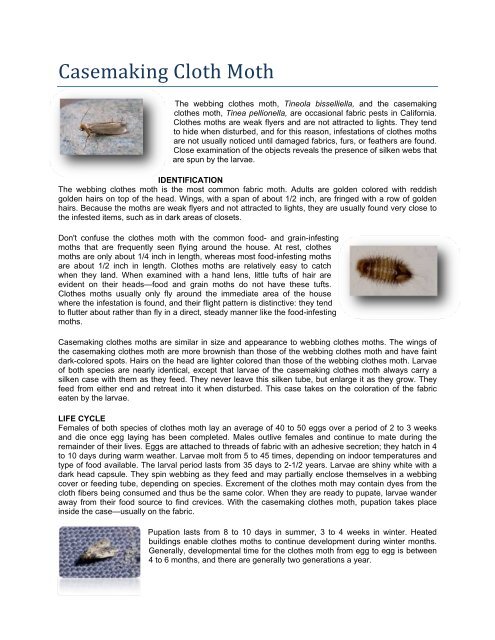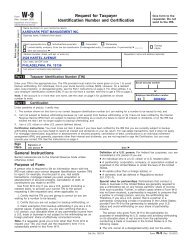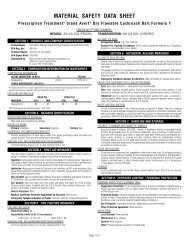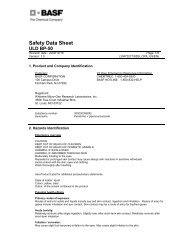Case Making Moth - Aardvarkpestmgmt.com - Aardvark Pest ...
Case Making Moth - Aardvarkpestmgmt.com - Aardvark Pest ...
Case Making Moth - Aardvarkpestmgmt.com - Aardvark Pest ...
- No tags were found...
Create successful ePaper yourself
Turn your PDF publications into a flip-book with our unique Google optimized e-Paper software.
<strong>Case</strong>making Cloth <strong>Moth</strong>The webbing clothes moth, Tineola bisselliella, and the casemakingclothes moth, Tinea pellionella, are occasional fabric pests in California.Clothes moths are weak flyers and are not attracted to lights. They tendto hide when disturbed, and for this reason, infestations of clothes mothsare not usually noticed until damaged fabrics, furs, or feathers are found.Close examination of the objects reveals the presence of silken webs thatare spun by the larvae.IDENTIFICATIONThe webbing clothes moth is the most <strong>com</strong>mon fabric moth. Adults are golden colored with reddishgolden hairs on top of the head. Wings, with a span of about 1/2 inch, are fringed with a row of goldenhairs. Because the moths are weak flyers and not attracted to lights, they are usually found very close tothe infested items, such as in dark areas of closets.Don't confuse the clothes moth with the <strong>com</strong>mon food- and grain-infestingmoths that are frequently seen flying around the house. At rest, clothesmoths are only about 1/4 inch in length, whereas most food-infesting mothsare about 1/2 inch in length. Clothes moths are relatively easy to catchwhen they land. When examined with a hand lens, little tufts of hair areevident on their heads—food and grain moths do not have these tufts.Clothes moths usually only fly around the immediate area of the housewhere the infestation is found, and their flight pattern is distinctive: they tendto flutter about rather than fly in a direct, steady manner like the food-infestingmoths.<strong>Case</strong>making clothes moths are similar in size and appearance to webbing clothes moths. The wings ofthe casemaking clothes moth are more brownish than those of the webbing clothes moth and have faintdark-colored spots. Hairs on the head are lighter colored than those of the webbing clothes moth. Larvaeof both species are nearly identical, except that larvae of the casemaking clothes moth always carry asilken case with them as they feed. They never leave this silken tube, but enlarge it as they grow. Theyfeed from either end and retreat into it when disturbed. This case takes on the coloration of the fabriceaten by the larvae.LIFE CYCLEFemales of both species of clothes moth lay an average of 40 to 50 eggs over a period of 2 to 3 weeksand die once egg laying has been <strong>com</strong>pleted. Males outlive females and continue to mate during theremainder of their lives. Eggs are attached to threads of fabric with an adhesive secretion; they hatch in 4to 10 days during warm weather. Larvae molt from 5 to 45 times, depending on indoor temperatures andtype of food available. The larval period lasts from 35 days to 2-1/2 years. Larvae are shiny white with adark head capsule. They spin webbing as they feed and may partially enclose themselves in a webbingcover or feeding tube, depending on species. Excrement of the clothes moth may contain dyes from thecloth fibers being consumed and thus be the same color. When they are ready to pupate, larvae wanderaway from their food source to find crevices. With the casemaking clothes moth, pupation takes placeinside the case—usually on the fabric.Pupation lasts from 8 to 10 days in summer, 3 to 4 weeks in winter. Heatedbuildings enable clothes moths to continue development during winter months.Generally, developmental time for the clothes moth from egg to egg is between4 to 6 months, and there are generally two generations a year.
Protecting Items in StorageClothes moths often damage articles that are not stored properly. Whenstoring susceptible items, be sure they are pest-free and clean, andplace them in an airtight container. Insect repellents can be placed in thestorage container. A new product made from lavender oil is available asa gel-filled sachet that can be used inside drawers and storage boxes, orhung in closets. Research studies are currently underway regarding theefficacy of this product.<strong>Moth</strong> balls, flakes, or crystals containing naphthalene or paradichlorobenzene are also available forprotecting clothes in storage. These materials are toxic and must be kept away from children and pets.They also leave an unpleasant odor on clothes and other cloth objects. If placed in contact with plasticbuttons, hangers, or garment bags, they may cause the plastic to soften and melt into the fabric. As thesechemicals evaporate, they produce vapors that, in sufficient concentration, will slowly kill insects. Thevapors build up to the required concentration only in an airtight container. If the container is not airtight,the chemicals only weakly repel adults and any larvae already on clothes continue to feed.Questions are often raised as to the effectiveness of cedar chests and closet floors made of cedar.Aromatic eastern red cedar, Juniperus virginiana, contains oil that is able to kill small larvae, but it doesnot affect large larvae. After several years, however, cedar loses this quality. Having the chest tightlyconstructed is more important in the long run than the type of wood used to make it.Freezing and HeatingClothes moths can also be controlled by heating the infested object for at least 30 minutes attemperatures over 120°F, freezing the object for several days at temperatures below 18°F, or fumigatingwith dry ice (see "Household Furnishings").TrappingTrapping is a relatively easy-to-use technique that helps to both detect a webbing clothes moth infestationand to reduce it. Pheromone traps are available to trap the webbing clothes moth, but not the casemakingclothes moth. Pheromones are chemicals (in this case a sex attractant) produced by an organism toaffect the behavior of other members of the same species. The sex pheromone attracts male moths intothe trap where they get stuck on the sticky sides. Because the pheromone specifically attracts clothesmoths, other moth species will not be attracted—conversely, webbing clothes moths will not be attractedto pheromone traps for other species such as grain-infesting moths. Pheromone traps for clothes mothsare available from major hardware stores.Place traps in closets and other areas where clothes are stored. Trapping not onlyallows you to detect the presence of webbing clothes moths but also providessome control because trapped males cannot mate. However, if you trap moths,you should also take other measures such as dry cleaning or laundering to protectclothes that were exposed to the moths.Using Insecticide SpraysIf clothes moths are detected, articles that cannot be dry cleaned, laundered, heated to temperatures over120°F, frozen, kept in cold storage, or fumigated with dry ice (see "Household Furnishings") can besprayed with an insecticide. Find a product that lists clothes moths on its label and follow the directionsexactly. Insecticides for clothes moths usually contain pyrethrins, which provide quick knockdown ofclothes moths, and most can be sprayed directly on fabrics if needed (in situations where fabrics cannotbe laundered or dry cleaned). Pyrethrin insecticides do not leave persistent toxic residues, which makesthem more suitable for clothes moth control in many cases than many other products.Some insecticides have an oil base. Do not spray them on silk, rayon, or other fabrics that stain easily. Donot use them around open flames, sparks, or electrical circuits. Do not spray them on asphalt-tile floors.
Use only lightly on parquet floors. On linoleums, first spray a small inconspicuousarea and let it dry to see if staining occurs.Widespread or heavy infestations often require the services of a professional pestcontrol applicator.Special SituationsRugs, carpets, furs, and household furnishings require special attention for protection from clothes moths.Rugs and furnishings made entirely of synthetic fibers are not affected. This includes most wall-to-wallcarpeting.Rugs and Carpets. Closely inspect areas beneath heavy furniture and along carpet edges for infestation.Area rugs can be dry cleaned or hung out in the sun and vacuumed. The edges on wall-to-wall carpetscan be pulled back so that an insecticide can be applied to both sides of infested carpets. Spray theupper surface of the carpet lightly to reduce the possibility of staining. If the rug pad contains animal hairor wool and has not been treated by the manufacturer, spray it also. It is preferable to wait until the rughas dried before putting any weight on it.Fur. Applying protective sprays to furs is not re<strong>com</strong>mended. If you store furs at home throughout thesummer, protect them with moth crystals, flakes, or balls; or frequently shake and air them. Furs in<strong>com</strong>mercial cold storage receive professional care and can be insured against damage.Household Furnishings. Some furniture, mattresses, and pillows are stuffed with animal products suchas hair or feathers. When clothes moths get into the stuffing, they cannot be controlled simply by sprayingthe outside surface of the item. The best way to eliminate them is to fumigate the item with dry ice or tohave a pest control or storage firm treat the infested item with a lethal gas in a fumigation vault.To fumigate an object with dry ice, place the item and the dry ice in a thick (4mils) plastic bag. (Do not handle dry ice with your bare hands because it willquickly freeze your skin.) If you use a plastic bag with a 30-gallon capacity, a1/2- to 1-lb piece of dry ice should be adequate. Seal the bag loosely at the topuntil all the dry ice has vaporized; this will allow the air to escape and keep thebag from bursting. When the dry ice is gone, tighten the seal and let the bag sitfor 3 or 4 days. Proper fumigation gives quick, satisfactory control, and kills allstages of clothes moths, although it does not prevent reinfestation.







